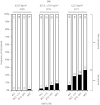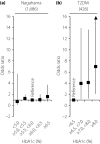Hyperglycemia in non-obese patients with type 2 diabetes is associated with low muscle mass: The Multicenter Study for Clarifying Evidence for Sarcopenia in Patients with Diabetes Mellitus
- PMID: 31074209
- PMCID: PMC6825926
- DOI: 10.1111/jdi.13070
Hyperglycemia in non-obese patients with type 2 diabetes is associated with low muscle mass: The Multicenter Study for Clarifying Evidence for Sarcopenia in Patients with Diabetes Mellitus
Abstract
Aims/introduction: Hyperglycemia is a risk factor for sarcopenia when comparing individuals with and without diabetes. However, no studies have investigated whether the findings could be extrapolated to patients with diabetes with relatively higher glycemic levels. Here, we aimed to clarify whether glycemic control was associated with sarcopenia in patients with type 2 diabetes.
Materials and methods: Study participants consisted of patients with type 2 diabetes (n = 746, the average age was 69.9 years) and an older general population (n = 2,067, the average age was 68.2 years). Sarcopenia was defined as weak grip strength or slow usual gait speed and low skeletal mass index.
Results: Among patients with type 2 diabetes, 52 were diagnosed as having sarcopenia. The frequency of sarcopenia increased linearly with glycated hemoglobin (HbA1c) level, particularly in lean individuals (HbA1c <6.5%, 7.0%, ≥6.5% and <7.0%: 18.5%; HbA1c ≥7.0% and <8.0%: 20.3%; HbA1c ≥8.0%: 26.7%). The linear association was independent of major covariates, including anthropometric factors and duration of diabetes (HbA1c <6.5%: reference; ≥6.5% and <7.0%: odds ratio [OR] 4.38, P = 0.030; HbA1c ≥7.0% and <8.0%: 4.29, P = 0.024; HbA1c ≥8.0%: 7.82, P = 0.003). HbA1c level was specifically associated with low skeletal mass index (HbA1c ≥8.0%: OR 5.42, P < 0.001) rather than weak grip strength (OR 1.89, P = 0.058) or slow gait speed (OR 1.13, P = 0.672). No significant association was observed in the general population with a better glycemic profile.
Conclusions: Poor glycemic control in patients with diabetes was associated with low muscle mass.
Keywords: Sarcopenia; Skeletal muscle mass; Type 2 diabetes.
© 2019 The Authors. Journal of Diabetes Investigation published by Asian Association for the Study of Diabetes (AASD) and John Wiley & Sons Australia, Ltd.
Figures


References
-
- Chen LK, Liu LK, Woo J, et al Sarcopenia in Asia: consensus report of the Asian Working Group for Sarcopenia. J Am Med Dir Assoc 2014; 15: 95–101. - PubMed
-
- Park SW, Goodpaster BH, Strotmeyer ES, et al Decreased muscle strength and quality in older adults with type 2 diabetes: the health, aging, and body composition study. Diabetes 2006; 55: 1813–1818. - PubMed
Publication types
MeSH terms
Substances
Grants and funding
- 17H04182, 17H04126/Grant-in-Aid for Scientific Research
- ek0210066, ek0210096/Japan Agency for Medical Research and Development
- 2510211, 15K08910, 16K12336/Japan Science and Technology Agency
- ek0109070, ek0109070, ek0109196, ek0109348/Japan Science and Technology Agency
- dk0207006/Comprehensive Research on Aging and Health Science Research Grants for Dementia

